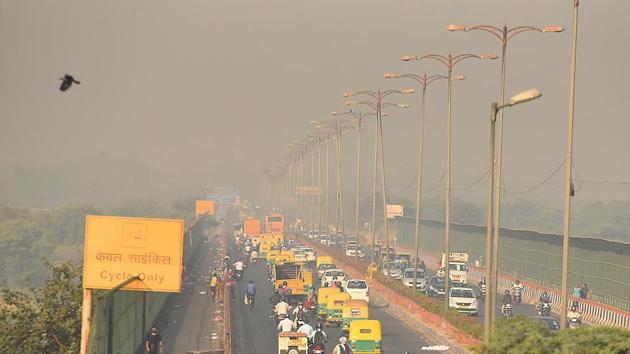Delhi: An agenda to bring back blue skies
A fundamental transformation is needed, aided by strong governance capacity
Every winter, when we cannot breathe, we discuss air pollution. But we need action not just in the few winter months, when the pollutants settle close to the ground because of inversion, when wind is low and moisture traps the toxins. We need to understand that sources of pollution — other than the stubble-burning in Punjab and Haryana — are constant. We just don’t feel that the air is foul and deadly because there is sun and wind, which disperses pollutants. But it does not make it better for our lungs.

The second thing we need to realise is that all soft and easy options for combating pollution are over. Delhi now needs transformational measures to drastically reduce toxins from combustion sources such as vehicles, power plants and industries which use coal for energy. We also need to step up implementation and enforcement on sources such as garbage-burning or construction-related dust. We also need to do much more to convince farmers not to burn stubble, but to use it to either fertilise their soil or to sell it for fuel to industry. The agenda for action is clear. The newly-formed Air Quality Commission (AQC) needs to hit the ground running.
It is not as if nothing has been done. The data on air quality shows a decreasing trend and this is good news. This is because governments, both at the Centre and state, have acted. I say this because we must have confidence that action will lead to results. Otherwise, we will drown in cynicism and procrastination.
First, there is the transition to Bharat Stage VI (BSVI) fuel and vehicle standards; this was a leapfrog action as the country jumped over one generation of vehicle emission technologies. The new generation BS VI heavy duty and diesel vehicles will be 80-90% cleaner than their predecessors. However, the result of this will only show up when there is fleet transition — that is when larger numbers of these cleaner vehicles come on to roads and replace the older vehicles. But let’s not discount the impact of much cleaner fuel that is now driving our vehicles.
Then there have been efforts to control gross-polluting vehicles — in Delhi, the problem was from diesel trucks that moved through the city at night when inversion was the highest. Based on Supreme Court (SC) directions, the numbers of these vehicles have drastically reduced by building expressways that allow diversion and congestion tax that provide deterrence.
The impact of this measure is showing up in the air quality charts.
There is also the ban on coal — brought about by the Delhi government — and the incentives for industry to change to piped natural gas. The only remaining coal-based power plant in Delhi, Badarpur, has been shut and the effort is to ramp up gas-based power generation at Bawana. New emission standards for clean coal power plants have also been notified — but are still not implemented. In the neighbouring states, brick kilns have been moved to cleaner technology of zigzag and now shut down by judicial orders.
So, there is action, there is improvement in air quality. But the bad news is that much more needs to be done. This is the agenda for the future.
Just think, during the lockdown, when we all saw blue skies, there was a complete lockdown — all vehicles were off the road; factories were shut. Clearly, the lockdown, with its devastating effect on the economy and livelihoods, is not the solution. But what this reveals is the scale of the intervention that is required to bring us clean air, even during the peak winter periods.
The scale was critical in the first-generation reform that Delhi undertook when it moved to compressed natural gas (CNG); it was a leapfrog solution; it was transformational as all gross-polluting vehicles such as buses and autorickshaws made the move to clean fuel in a short time. The second-generation action focused on each source. Now, we need the third wave.
What then is the way ahead? We need to move from polluting coal (pet coke and furnace oil have already been banned) across the region. This would mean moving to natural gas or ensuring that there is supply of reliable and affordable power. This is possible, but will require shifting fiscal strategies to incentivise clean fuel.
But this is not enough. We need to do much more to reduce the number of vehicles — remember every time we clean up the tailpipe of the vehicle, but then add many more on the road, the end result of clean air is negated. We need massive augmentation of buses, not just in Delhi but other neighbouring towns and linking public transport with last-mile connectivity. The right to walk and cycle is linked to the right to clean air.
However, this agenda remains incomplete if we don’t focus on what is really broken — the institutional capacity for governance of our cities.
We cannot stop the burning of garbage that is littering our roads and grounds, unless there is municipal capacity. We cannot step up enforcement against polluters, unless the pollution control boards have the required strength to monitor, inspect and penalise. This is where AQC will have its work cut out. Building new institutions, without repairing and strengthening the old, is not the answer.
This is the real agenda for clean air, blue skies and clear lungs in our cites. Our right to breathe is possible, but only if we don’t gloss over some hard truths and tough action.



